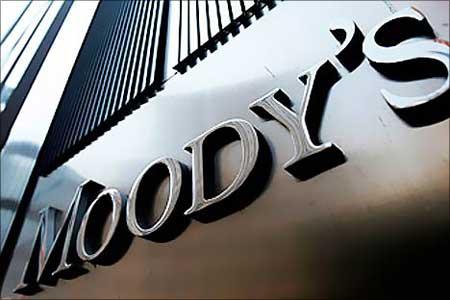Photographs: Reuters
International credit ratings agency Moody's Investors Service changed its outlook for India's banking system to negative from stable due to concerns that an increasingly challenging operating environment will adversely affect asset quality, capitalisation, and profitability.
However, brushing aside the downgrade of Indian banks by Moody's, the Indian government said the rating has no significance as domestic lenders are much stronger than their global peers.
"We are not concerned. We are not affected by the downgrade. Looking at how the global banks are faring, we are much stronger and the ratings have no significance," financial services secretary D K Mittal told PTI.
"I don't see any reason for the downgrade. Our banks are fully capitalised and the government will continue to capitalise it," Mittal added.
As regards bad loans of Indian banks, Mittal said, "Our NPAs are better compared to other global banks. Indian economy is growing at 8 per cent, so the stress that Moody's has pointed out, is more outside India than within. We are growing better and our credit growth will also be good."
Meanwhile, Vineet Gupta, a Moody's vice president and senior analyst, said: "India's economic momentum is slowing because of high inflation, monetary tightening, and rapidly rising interest rates. At the same time, concerns have emerged over the sustainability of the recovery in the United States and Europe, and the rise in the borrowing programme of the Indian government, which could drain funds away from the private credit market."
Gupta was speaking on the release of Moody's latest outlook for the Indian banking system, and which he authored along with other senior Moody's analysts. The outlook applies for the next 12-18 months.
Moody's rates 15 commercial banks in India that together account for about 66 per cent of the system's total assets as of March 2011.
. . .
Moody's downgrades Indian banks, govt fumes
Photographs: Reuters
The system is dominated by public-sector banks, which account for around 75 per cent of the market in asset terms.
The weighted average stand-alone banking financial strength rating (BFSR) is D+, and mapping to a Baseline Credit Assessment of Baa3. The average long-term deposit rating is Baa2/Prime-2.
"With asset quality, given the tightening environment, we anticipate that it will deteriorate over the next 12-18 months, thereby causing an increase in provisioning needs for the banks in FY2012 and FY2013," says Gupta.
"Meanwhile, with capitalisation, we expect loan growth to be a strain on the banks' capital over the horizon of this outlook. As monetary conditions tighten and economic activities slow, we expect bank loan growth to fall to 16-18 per cent in FY2012 and FY2013, from 21 per cent in FY2011," says Gupta."And with profitability, we expect it to come under pressure due to lower interest margins as deposit rates re-price and get a further push from the latest liberalization on savings deposit rates," says Gupta.
. . .
Moody's downgrades Indian banks, govt fumes
Photographs: Reuters
The new Moody's report further concludes that bank ratings may come under downward pressure, although currently, the negative outlook on the banking system contrasts with the stable outlook assigned to the bank financial strength ratings of 14 of the 15 rated banks.
For those banks with weaker capital ratios on average and higher asset quality pressures relative their individual rating levels, their standalone ratings are likely to come under pressure as underscored by Moody's downgrade of the State Bank of India's BFSR to D+/Stable/Baa3 from C-/Stable/Baa2 on 4 October 2011.
But, on the positive side, Moody's recognizes that Indian banks' stable customer deposit base and high level of government securities holdings provide them with a resilient funding and liquidity profile that buffer them against destabilizing shocks.
Moody's also expects the government to remain committed towards providing support to both public and private banks. Such potential support translates to an average one-notch uplift to the banks' debt and deposit ratings to Baa2, compared with their standalone base line credit assessment of Baa3.
. . .
Moody's downgrades Indian banks, govt fumes
Photographs: Reuters
Banking system outlook publications represent Moody's view on the broad operating environment in which banks of a given system operate and, more specifically, on the influence that macroeconomic, competitive, and regulatory trends may have on banks' asset quality and capital and, ultimately, on their funding and profitability.
As such, a 'stable' outlook is one that implies an environment that favours sustainable profitability and limited volatility for a period of at least four to six quarters.
A 'negative' outlook is one that is characterised by volatility and uncertain conditions.
A 'positive' outlook is one in which banks are expected to rest on solid ground for the duration of the time horizon -- 12-18 months --- and in which banks are expected to grow steadily as a result of a favourable environment during that period.





article